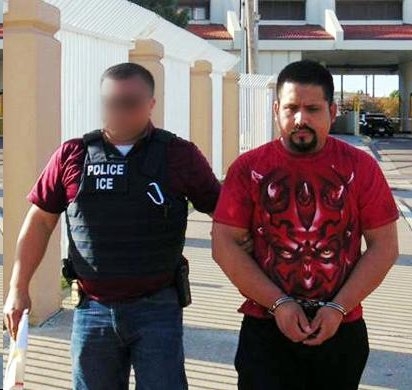ICE removes Mexican wanted on murder charges
 A 30-year-old man who fled from Mexico to evade murder charges was removed Tuesday by U.S. Immigration and Customs Enforcement’s (ICE) Enforcement and Removal Operations (ERO).
A 30-year-old man who fled from Mexico to evade murder charges was removed Tuesday by U.S. Immigration and Customs Enforcement’s (ICE) Enforcement and Removal Operations (ERO).Jose Alvarado is wanted in Coahuila, Mexico, in connection with the 2002 murder of Saul Chavez Rodriguez. The Procuraduria General de Justicia del Estado (PJGE) in Mexico issued a warrant for his arrest March 10, 2015. According to Mexican authorities, Chavez Rodriguez and Alvarado agreed to race each other for $200 pesos, the equivalent of $15 in U.S. currency. Chavez Rodriguez subsequently backed out of the race and Alvarado responded by pulling out a .45 caliber pistol and shooting Chavez Rodriguez, who died on the scene.
Alvarado, who entered the U.S. in 2005 without admission or parole, was ordered removed by an immigration judge April 10, 2007, in absentia. Since 2005, Alvarado has had several encounters with U.S. law enforcement including a 2014 Wisconsin arrest for driving while intoxicated.
Upon his arrival in Mexico Tuesday, Alvarado was immediately handed over to Mexican law enforcement authorities.
“Our country will not be used as a hiding place by criminals fleeing justice,” said ERO St. Paul Field Office Director Scott Baniecke. “Our message is clear: If you are unlawfully present in our country and running from justice, you will be located and removed.”
Since Oct. 1, 2009, ERO has removed more than 1,150 foreign fugitives from the United States who were sought in their native countries for serious crimes, including kidnapping, rape and murder. ERO works with the ICE Homeland Security Investigations (HSI) Office of International Operations, foreign consular offices in the United States, and Interpol to identify foreign fugitives illegally present in the United States.
ERO coordinates the removal of criminals, foreign fugitives and others ordered deported. Last year alone, ERO removed 315,943 individuals from the United States. ICE is focused on smart and effective immigration enforcement that prioritizes its resources based on those who pose the biggest threat to national security, border security and public safety. ICE’s civil enforcement efforts are based on priorities set by the Secretary of Homeland Security in November 2014.


Great blog.Really looking forward to read more.